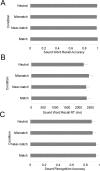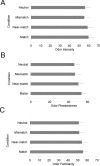An Exception to Mental Simulation: No Evidence for Embodied Odor Language
- PMID: 29442364
- PMCID: PMC6001635
- DOI: 10.1111/cogs.12593
An Exception to Mental Simulation: No Evidence for Embodied Odor Language
Abstract
Do we mentally simulate olfactory information? We investigated mental simulation of odors and sounds in two experiments. Participants retained a word while they smelled an odor or heard a sound, then rated odor/sound intensity and recalled the word. Later odor/sound recognition was also tested, and pleasantness and familiarity judgments were collected. Word recall was slower when the sound and sound-word mismatched (e.g., bee sound with the word typhoon). Sound recognition was higher when sounds were paired with a match or near-match word (e.g., bee sound with bee or buzzer). This indicates sound-words are mentally simulated. However, using the same paradigm no memory effects were observed for odor. Instead it appears odor-words only affect lexical-semantic representations, demonstrated by higher ratings of odor intensity and pleasantness when an odor was paired with a match or near-match word (e.g., peach odor with peach or mango). These results suggest fundamental differences in how odor and sound-words are represented.
Keywords: Audition; Embodiment; Memory; Mental simulation; Olfaction.
Copyright © 2018 The Authors. Cognitive Science - A Multidisciplinary Journal published by Wiley Periodicals, Inc. on behalf of Cognitive Science Society.
Figures





Similar articles
-
Congruent sound can modulate odor pleasantness.Chem Senses. 2014 Mar;39(3):215-28. doi: 10.1093/chemse/bjt070. Epub 2013 Dec 24. Chem Senses. 2014. PMID: 24368256
-
Duality of Smell: Route-Dependent Effects on Olfactory Perception and Language.Chem Senses. 2021 Jan 1;46:bjab025. doi: 10.1093/chemse/bjab025. Chem Senses. 2021. PMID: 34007980
-
Auditory-olfactory integration: congruent or pleasant sounds amplify odor pleasantness.Chem Senses. 2011 Mar;36(3):301-9. doi: 10.1093/chemse/bjq129. Epub 2010 Dec 16. Chem Senses. 2011. PMID: 21163913
-
An odor is not worth a thousand words: from multidimensional odors to unidimensional odor objects.Annu Rev Psychol. 2010;61:219-41, C1-5. doi: 10.1146/annurev.psych.60.110707.163639. Annu Rev Psychol. 2010. PMID: 19958179 Review.
-
Odor-induced recall of emotional memories in PTSD-Review and new paradigm for research.Exp Neurol. 2016 Oct;284(Pt B):168-180. doi: 10.1016/j.expneurol.2016.08.001. Epub 2016 Aug 7. Exp Neurol. 2016. PMID: 27511295 Review.
Cited by
-
Olfactory abstraction: a communicative and metacognitive account.Philos Trans R Soc Lond B Biol Sci. 2023 Feb 13;378(1870):20210369. doi: 10.1098/rstb.2021.0369. Epub 2022 Dec 26. Philos Trans R Soc Lond B Biol Sci. 2023. PMID: 36571118 Free PMC article.
-
Dutch sensory modality norms.Behav Res Methods. 2022 Jun;54(3):1306-1318. doi: 10.3758/s13428-021-01656-9. Epub 2021 Sep 10. Behav Res Methods. 2022. PMID: 34505998 Free PMC article.
-
Ecological Meanings: A Consensus Paper on Individual Differences and Contextual Influences in Embodied Language.J Cogn. 2023 Oct 10;6(1):59. doi: 10.5334/joc.228. eCollection 2023. J Cogn. 2023. PMID: 37841670 Free PMC article.
-
Dissociating voluntary mental imagery and mental simulation: Evidence from aphantasia.Mem Cognit. 2025 Jun 10. doi: 10.3758/s13421-025-01731-y. Online ahead of print. Mem Cognit. 2025. PMID: 40493310
-
Linguistic features of fragrances: The role of grammatical gender and gender associations.Atten Percept Psychophys. 2019 Aug;81(6):2063-2077. doi: 10.3758/s13414-019-01729-0. Atten Percept Psychophys. 2019. PMID: 31044396 Free PMC article.
References
-
- Andrade, J. , & Donaldson, L. (2007). Evidence for an olfactory store in working memory? Psychologia: An International Journal of Psychology in the Orient, 50(2), 76–89. https://doi.org/10.2117/psysoc.2007.76 - DOI
-
- Andrade, J. , May, J. , Deeprose, C. , Baugh, S.‐J. , & Ganis, G. (2014). Assessing vividness of mental imagery: The Plymouth Sensory Imagery Questionnaire. British Journal of Psychology, 105(4), 547–563. - PubMed
-
- Ayabe‐Kanamura, S. , Kikuchi, T. , & Saito, S. (1997). Effect of verbal cues on recognition memory and pleasantness evaluation of unfamiliar odors. Perceptual and Motor Skills, 85(1), 275–285. https://doi.org/10.2466/PMS.85.5.275-285 - DOI - PubMed
-
- Barros‐Loscertales, A. , Gonzalez, J. , Pulvermuller, F. , Ventura‐Campos, N. , Bustamante, J. C. , Costumero, V. , Parcet, M. A. , & Avila, C. (2012). Reading salt activates gustatory brain regions: fMRI evidence for semantic grounding in a novel sensory modality. Cerebral Cortex, 22(11), 2554–2563. https://doi.org/10.1093/cercor/bhr324 - DOI - PMC - PubMed
-
- Barsalou, L. W. (1999). Perceptual symbol systems. Behavioral and Brain Sciences, 22(4), 637–660. https://doi.org/10.1017/S0140525X99532147 - DOI - PubMed
Publication types
MeSH terms
LinkOut - more resources
Full Text Sources
Other Literature Sources

